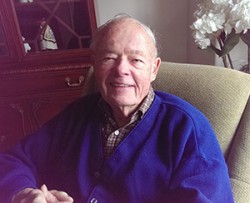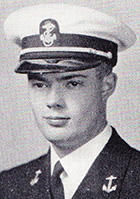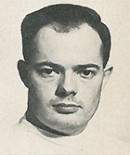 Dr. Donald Raleigh (’50), a member of our first graduating class, entered dental school after his discharge from the Navy as a lieutenant commander in 1946. Serving on the battleship USS Maryland, he survived the Japanese attack on Pearl Harbor on Dec. 7, 1941 and went on to fight the Pacific campaign of World War II. He viewed the surrender on the USS Missouri through a fire-control rangefinder on the deck of the USS Wilkes Barre CL103. Here he shares his recollections about returning to civilian life and attending the School of Dentistry.
Dr. Donald Raleigh (’50), a member of our first graduating class, entered dental school after his discharge from the Navy as a lieutenant commander in 1946. Serving on the battleship USS Maryland, he survived the Japanese attack on Pearl Harbor on Dec. 7, 1941 and went on to fight the Pacific campaign of World War II. He viewed the surrender on the USS Missouri through a fire-control rangefinder on the deck of the USS Wilkes Barre CL103. Here he shares his recollections about returning to civilian life and attending the School of Dentistry.
Deciding on dentistry: One of my shipmates was Lt. Frank Gray, a dental corpsman who was a great proponent of dentistry as a profession. He explained how dentistry required exceptional hand-eye coordination as well as academic achievement.
Most dentists own their office and are their own boss. After five years of active duty, I was tired of taking orders and being told what I was going to do and where. My wife and I wished to have a family and live a normal life. I had read about the plans for a new medical and dental school at the University of Washington, so I went to see the admissions officer – Dr. Boa Thomas, an ex-Navy dentist. I was still in my uniform and we had instant rapport. He outlined the academic requirements required for entrance to the School of Dentistry. Since my undergraduate degree was in business administration, I needed organic chemistry, qualitative and quantitative analysis and zoology. Fortunately, I was able to fulfill the requirements in three quarters before the start of the School of Dentistry in the fall of 1946. My instructor in zoology was Dr. Dixy Lee Ray, the future governor of Washington and chair of the U.S. Atomic Energy Commission. She gave me an A grade.

Dental school: Our first dental quarters were in the fourth floor attic of Bagley Hall and consisted of 50 lab benches fitted with gas, air and electrical connections. We were issued all the instruments that were required for this introduction to the science and art of dentistry. The GI Bill paid for our instruments and supplies as well as four years of school tuition. This government program paid for itself seven times over in income taxes from the college graduates. All but two of the members of the first class were GIs and one of the two was Bill McGovern, the starting center for the UW football team. He had the distinction to be flown to the out-of-state games because he had to attend the Friday dental classes. The rest of the team took the train. Another was Percy Hansen, an Army Ranger in the Philippines, who had killed more enemy soldiers than there were men in our class. We were survivors and did not talk much about our war experiences.
Dean Ernest Jones addressed the first class and told us what a fine group of dentists we were and that he expected every one of us to receive our DDS. Forty-four members of that entering class did graduate, and all passed the Washington State Board on the first try. Dr. Jones was very supportive of his students and strove for a harmonious relationship with the faculty. He was able to recruit outstandingly talented professors as well as highly qualified individuals from the local dental community. Seattle was very fortunate in having an active group of study clubs which resulted in the delivery to the public of superior dentistry. Dr. Robert Hampson was the father of Bob Hampson, a student of the first class. Dr. Hampson was an outstanding dentist and volunteered many days to the School at considerable cost to himself. Another was Dr. Ozzie Anderson, who specialized in crown and bridge. He did beautiful porcelain crowns and inlays and guided many students into fine dentistry.

The third- and fourth-year students produced much better dentistry than that found in the mouths of most private patients because of the oversight of each step by an instructor. It started with the examination and treatment plan for each patient. For an amalgam or gold foil, the cavity preparation was approved and finally the condensation and finishing. In the case of an inlay, this step-by-step approval by an instructor included the impression, wax pattern and casting. Each part of the procedure had to be perfect. Our cavity preparations were done with belt-driven, slow-speed handpieces using steel and carbide burrs, diamonds and hand instruments. For gold foil, we used hand condensing instruments and a small pneumatic condenser. If a student can become proficient in gold foil restorations, he or she will become a better overall dentist.
The state board was the next challenge. I felt confident that I could pass with no problem. The UW School of Dentistry had provided the latest in curriculum and the newest and best physical plant in the country. The mock board went very well. I remember Dean Jones looking at my two-surface amalgam preparation and I said, “Dr. Jones, do you think that this will get past the board?” And he put his hand on my shoulder and said, “Son, that will get past anywhere in the world.”
All 44 graduates passed the board on the first try. That is outstanding, for it is a tough examination and so many things can go wrong to cause a candidate to fail. The requirements were a three-unit bridge, a two-surface inlay, a two-surface amalgam, a Class Three gold foil and a prophylaxis – all in three days.
I graduated number two in the class standing and was inducted into Omicron Kappa Upsilon, the dental honorary fraternity.
Life off campus: A lot of the dental students were married, and many of them lived in the student housing in Union Bay Village. I was fortunate in finding a small house in the back yard of Prof. Thomas Herman’s home just north of campus. It was in sorry shape, having been built on cedar blocks which over time had rotted. I spent a week leveling and supporting the structure on cement blocks. His kitchen and bathroom had to be built, the floors covered with linoleum and carpet. I painted inside and out to make this a comfortable home for four years. At first, refrigeration was by an old-fashioned icebox, but as production of household appliances got under way, I was able to get a Sears Coldspot refrigerator and an electric water heater.
My wife and I married in 1944 during my tour of duty in the construction of a new light cruiser in the Philadelphia Navy Yard. We elected to start a family during the war since there was a possibility that I might not be coming back. That changed so that by the end of dental school we had a boy of 3 and a girl of 1, with another on the way. Alison was an anthropology major with a degree from the University of California. She substituted as secretary for Dr. Erna Gunther in the Burke Museum on campus. She was a very intelligent young lady with a Phi Beta Kappa key to prove it. Our children must have inherited some of her smarts, for between them they have 10 years of postgraduate education and are all doing well. Alison died of colon cancer in 1991. (Dr. Raleigh took a new bride, Alda, in 1992, and they live in Edmonds, Wash. – Editor)